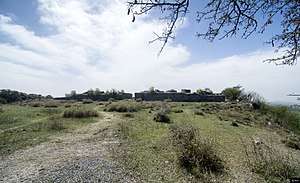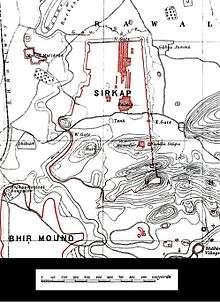Kunala Stupa
| Kunala Stupa | |
|---|---|
 General view of Kunala Stupa today. | |
 Shown within Pakistan | |
| Basic information | |
| Location | Pakistan |
| Geographic coordinates | 33°45′02″N 72°49′50″E / 33.750424°N 72.830479°ECoordinates: 33°45′02″N 72°49′50″E / 33.750424°N 72.830479°E |
| Affiliation | Buddhism |
| Region | Gandhara |
| Year consecrated | 2nd century CE |
| Ecclesiastical or organizational status | Stupa ruins |
| Status | Artifacts removed |
Kunala Stupa is a Buddhist stupa and monastery complex to the south-east of Taxila, on a hill about 200 meters just south of Sirkap, Pakistan, thought to date to the 2nd century CE.[1] It is located on a hill overlooking the ancient Indo-Greek city of Sirkap.[2]
Its name come from Kunala, a son of Ashoka.[3] Kunala, the legitimate heir to the throne had been blinded by one of Ashoka's queens, Tishyaksha, due to jealousy for his beautiful eyes. After years of wandering, Kunala reutnited with his father Ashoka, and was treated by a doctor from Taxila.[1][4]
Buddhist pilgrims with eye imparement came to the stupa with the hope of being cured.[1]
The Kunala stupa was visited by the Chinese pilgrim Xuanzang, who wrote an account of it.[1][4]
 Kunala Stupa circa 1910.
Kunala Stupa circa 1910. Kunala Stupa monastery.
Kunala Stupa monastery. Kunala Stupa stonework.
Kunala Stupa stonework. Kunala stupa and monastery are on the hill just south of Sirkap.
Kunala stupa and monastery are on the hill just south of Sirkap.
References
- 1 2 3 4 Marshall, Sir John Hubert (1951). Taxila: An Illustrated Account of Archaeological Excavations. CUP Archive. p. 348.
- ↑ Boda, Sharon La (1995). International Dictionary of Historic Places: Asia and Oceania. Taylor & Francis. p. 807. ISBN 9781884964046.
- ↑ Samad, Rafi U. (2011). The Grandeur of Gandhara: The Ancient Buddhist Civilization of the Swat, Peshawar, Kabul and Indus Valleys. Algora Publishing. p. 160. ISBN 9780875868585.
- 1 2 Wriggins, Sally (2008). The Silk Road Journey With Xuanzang. Basic Books. p. 171. ISBN 9780786725441.
This article is issued from
Wikipedia.
The text is licensed under Creative Commons - Attribution - Sharealike.
Additional terms may apply for the media files.